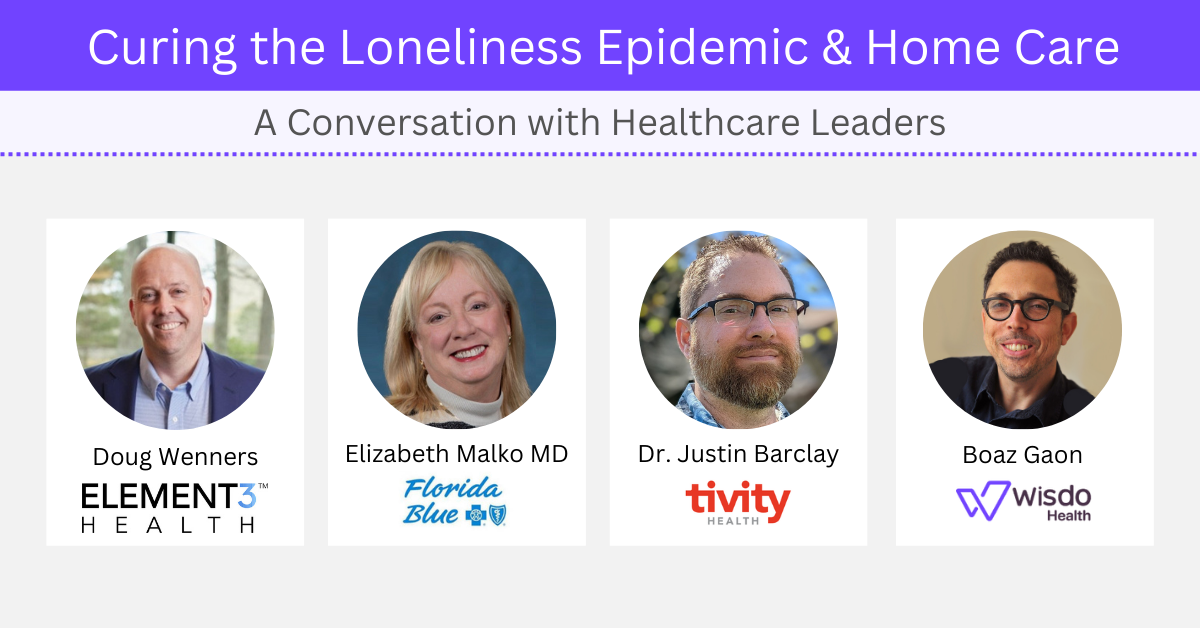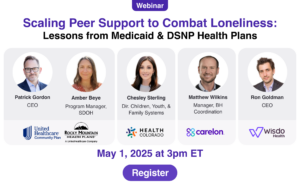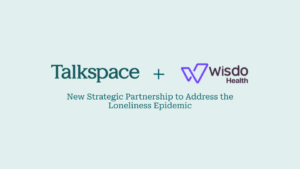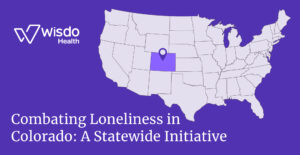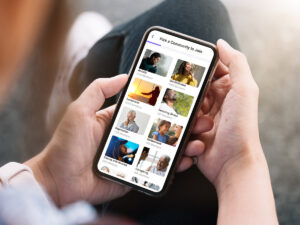The loneliness epidemic currently affects one-third of US adults aged 45 and over [1]. This further complicates chronic mental and physical health disorders, and adherence to treatment, and leads to an increase of hospitalizations and avoidable medical costs, currently estimated at $161 billion annually for Medicare Advantage and commercial populations [2].
Given the devastating effects of loneliness on those coping with chronic conditions, Wisdo Health invited some of the leading voices in healthcare, Dr. Justin Barclay, VP of Consumer Insights & Analytics at Tivity Health, Dr. Elizabeth Malko, MD, VP and CMO at Florida Blue, and Doug Wenners CEO at Optum at Home and Element 3, to discuss how this loneliness epidemic can be addressed in home care. The conversation was moderated by Wisdo Health Founder and CEO, Boaz Gaon.
The Five Trends Tivity Health Has Discovered Through its SilverSneakers Program
The conversation began with Dr. Barclay’s case for the impact of loneliness and social isolation among the fastest-growing segment within the already-vulnerable Medicare Advantage populations – the underserved.
Here are five trends that Tivity Health’s SilverSneakers Program has revealed:
- Habits that support healthy aging and longevity have become ubiquitous. In addition to adopting physical fitness into daily life, many Medicare Advantage members are regularly utilizing mental enrichment and social connection solutions, as well.
- The above trend leads individuals to become more flexible with regard to venue and method of exercise, based on ever-changing needs and schedules.
- Senior technology use has accelerated dramatically since COVID.
- Given the above, digital healthcare solutions should be designed to be easily accessible for Medicare Advantage members.
- COVID has lasting impacts on the social life and health of MA populations. In fact, one in four seniors is still uncomfortable socializing in public, according to Dr. Barclay.
Dr. Barclay says that programs like SilverSneakers can address these trends. Through the program, Tivity Health members report improved quality of life, self-efficacy, and health. As for loneliness – more than half have made new and valuable friendships from a community fitness program.
How Florida Blue Prioritizes Support for Lonely Caregiving MA Members
Continuing with the theme of the urgency around underserved MA populations, Dr. Malko fixed the focus of the conversation onto a particularly underserved population with a poignant statement: “You either are a caregiver, you have been a caregiver, or you will be a caregiver.”
She pointed out that there are 34 million unpaid caregivers in the US, whose care is estimated to be worth around $450 billion. Most of those caregivers are women, and many are part of the Medicare Advantage population, with just 27% in the sandwich generation.
Healthcare and employers need to be doing better to support caregiving MA members. This starts with understanding exactly what caregivers offer, and what they give up in the process:
Caregivers offer
- Social support – particularly in the case of caregiving for elderly parents
- Practical, day-to-day support – Scheduling appointments, providing transportation, doing household chores, meal preparation, advocacy with healthcare providers, and working with a healthcare provider.
In the process, many caregivers give up
- Employment – this allows for more time to care for their loved ones
- Social health and well-being – caregiving is isolating, expensive, and often comes at the expense of health-promoting activities like exercise
The good news is that there are solutions that are already available: benefits like Papa Pals and Meals on Wheels, as well as volunteer community org’s, practical tools that aid in daily tasks like scheduling appointments and reminders, employee programs, and grants.
The Impact of Loneliness on Frailest Elderly Populations, as Documented by Optum at Home
Mr. Wenners wrapped up the panel discussion by describing the findings of Optum at Home regarding the effects of loneliness and social isolation on the health and well-being of America’s frailest populations:
Many of these members cope with daily obstacles to health and well-being utterly alone. To illustrate this, Mr. Wenners pointed out that one of the most common reasons for hospitalizations among frail populations is sepsis, often as a result of common illnesses like UTIs. Without a family member at their side to notice a fever or other warning signs of deteriorating health, a common illness can easily become deadly.
Meaningful social relationships give us life purpose, and thus are “critical for health and longevity.” Mr. Wenners pointed out how, among women who undergo treatment for breast cancer, those who are mothers have a higher survival rate than the ones who are not. He also referred to an 84-year-long Harvard Study, the longest running study on adult development in the world, which has established that meaningful social connection is the largest contributor to health and longevity.
Conclusion
We need to do more to better support caregivers and frail populations in light of the physical and mental effects of loneliness and social isolation, including people who receive health services at home, where the risk of rising loneliness is high.
Given the acceleration of technology use among these populations, leading healthcare providers, as well as employers, need to consider offering digital tools for practical and social support.
A special thank you to our esteemed panelists for taking part in this important conversation. The entire recording of the webinar may be viewed here.

